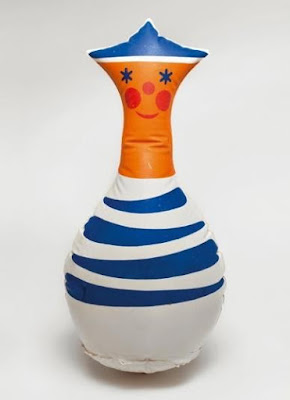 |
| Image ref: Libuše Niklová with her Tomcat accordion toy. Image credit: https://maammo.com/blogs/stories/the-future-belongs-to-plastic-the-toys-of-libuse-niklova |
Although the Czech Republic was (and still is) famous for its traditional, hand crafted, wooden toys, Libuše Niklová became well-known for her iconic toy designs made in plastics. She studied and worked at a time when new plastics materials were becoming commercially available and new plastics manufacturing technologies were emerging and evolving. She readily exploited this, stating:
“Development cannot be held back. In the future products from plastic matter will surround man just like the air, and they will become commonplace. Increasingly, natural materials will be a luxury and the object of admiration. The future, however, belongs to plastic.” (Bruthansová, 2013, p.11).
 |
| Image ref: Squeaky toys: Alik the Dog and Kitty with a Ball, 1956-58. Image credit: Bruthansová, 2013, p.46. |
In 1961 she joined Fatra Napajedla, a plastics manufacturer that had been producing toys since the 1940s, initially made of rubber and then unplasticised PVC. In 1948 Fatra introduced a range of inflatable rubber toys and in 1953 developed a plasticised PVC they trademarked as ‘Novoplast’. It was here that Niklová invented the two designs that have joined MoDiP’s collections.
 |
| Image ref: AIBDC : 008484, Tomcat accordion toy, 1963. Image credit: Katherine Pell. |
In 1963, inspired by a flexible, accordion-pleated, thin-walled tube that engineers at Fatra had been developing for a new flush cistern, Niklová introduced the first of her accordion toys: Tomcat. Made of blow moulded polyethylene, the body of the toys incorporated this bellows element which, due to the insertion of a whistle, would emit a sound when stretched. There were 11 accordion toys in total (10 animals and 1 baby), sold unassembled in packaging that
Niklová also designed, although sadly, this did not accompany MoDiP’s example.
 |
| Image ref: Packaging designed by Libuše Niklová for her accordion toy range. Image credit: https://www.makestudioinc.com/single-post/2016/02/02/FEATURED-ARTIST-Libuse-Niklova-19341981 |
 |
| Image ref: The innovative double chamber, inflatable PVC rocking sailor, 1963. Image credit: https://maammo.com/blogs/stories/the-future-belongs-to-plastic-the-toys-of-libuse-niklova |
However, one of her most notable inventions, the PVC inflatable toy seat, was devised six years later in 1969. Deliberately designed in a move away from children’s furniture being simply a scaled down version of the adult model, the whistling animals were not supposed to be passive seating but rather a toy to sit on and bounce around the room. The Buffalo was designed in 1971, joined in 1976 by a calf (MoDiP’s example).
 |
| Image ref: AIBDC : 008483, Buffalo calf inflatable, 1976. Image credit: Katherine Pell. |
Niklová sadly died in 1981 and in 2000, Fatra stopped manufacturing toys but the company re-released the Buffalo in 2010 to accompany a retrospective exhibition of the designer’s work. In 2013 they also commissioned several contemporary Czech designers to re-interpret her inflatables. MoDiP has added a modern, full-sized, inflatable Buffalo toy seat to the collection as well as a bull terrier reinterpretation, designed by Jan Čapek.
 |
| Image ref: AIBDC : 008494, Bull terrier inflatable, yet to be inflated, 2013! Image credit: Katherine Pell. |
Libuše Niklová believed that children should not be static observers when playing and so designed toys that would engage with all of the senses, offering tactile, olfactory, optical and acoustic development. She created over 200 different toy designs throughout her career and held 9 patents relating to plastics manufacturing. Her knowledge, understanding and passion for using this material resulted in some of the first mass-produced toys in Czechoslovakia, with Tomcat and the Buffalo being listed within the 100 Czech design icons project in 2005, a selection made by a group of the country’s leading design experts. MoDiP has also acquired the Libuše Niklová monograph (Bruthansová, 2013) which contains a comprehensive catalogue of all of her work. I have absolutely loved reading it and am thrilled that MoDiP has been able to represent this important designer within the collection: the objects and book can all be viewed on request.
 |
| Image ref: Inflatable Buffalo parent and calf. Image credit: Bruthansová, 2013, p.197. |
http://bruthansova.blogspot.com/2010/04/libuse-niklovas-exhibition-in-prague.html
https://coolhunting.com/design/libuse-niklova-fatra-toys/
https://www.designboom.com/design/plastique-ludique-at-les-arts-decoratifs-paris/
https://www.makestudioinc.com/single-post/2016/02/02/FEATURED-ARTIST-Libuse-Niklova-19341981
https://maammo.com/blogs/stories/the-future-belongs-to-plastic-the-toys-of-libuse-niklova
https://www.moma.org/explore/inside_out/2012/09/13/manufacturing-poetry-the-toys-of-libuse-niklova/
https://en.wikipedia.org/wiki/Libu%C5%A1e_Niklov%C3%A1
https://www.youtube.com/watch?v=SHqF-LcsWyc&feature=youtu.be










